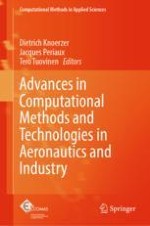2022 | OriginalPaper | Chapter
8. Load Control on the Future Greener Aircraft by Circulation Control
Authors : Yonghong Li, Ning Qin
Published in: Advances in Computational Methods and Technologies in Aeronautics and Industry
Publisher: Springer International Publishing
Activate our intelligent search to find suitable subject content or patents.
Select sections of text to find matching patents with Artificial Intelligence. powered by
Select sections of text to find additional relevant content using AI-assisted search. powered by
